
A game controller, gaming controller, or simply controller, is an input device or input/output device used with video games or entertainment systems to provide input to a video game. Input devices that have been classified as game controllers include keyboards, mice, gamepads, and joysticks, as well as special purpose devices, such as steering wheels for driving games and light guns for shooting games. Controllers designs have evolved to include directional pads, multiple buttons, analog sticks, joysticks, motion detection, touch screens and a plethora of other features.
NewTek, Inc., was a San Antonio, Texas–based hardware and software company that produced live and post-production video tools and visual imaging software for personal computers. The company was founded in 1985 in Topeka, Kansas, United States, by Tim Jenison and Paul Montgomery. On April 1, 2019, it was announced that NewTek would be acquired by Vizrt.
VAIO is a brand of personal computers and consumer electronics, currently developed by Japanese manufacturer VAIO Corporation, headquartered in Azumino, Nagano Prefecture. VAIO was formerly a brand of Sony, introduced in 1996, until it offloaded it into an independent company in 2014; Japan Industrial Partners owns VAIO Corporation, with Sony maintaining a minority stake. Sony still holds the intellectual property rights for the VAIO brand and logo. In November 2024, it was announced that Japanese retailer Nojima will take control of Vaio, expected to finalize in January 2025.
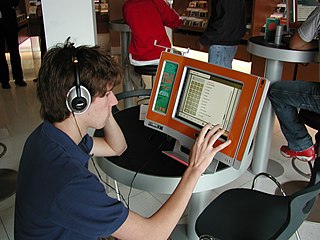
A touchscreen is a type of display that can detect touch input from a user. It consists of both an input device and an output device. The touch panel is typically layered on the top of the electronic visual display of a device. Touchscreens are commonly found in smartphones, tablets, laptops, and other electronic devices. The display is often an LCD, AMOLED or OLED display.
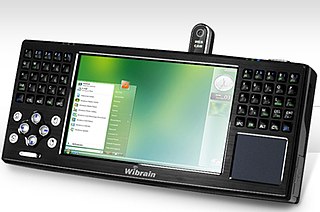
An ultra-mobile PC, or ultra-mobile personal computer (UMPC), is a miniature version of a pen computer, a class of laptop whose specifications were launched by Microsoft and Intel in Spring 2006. Sony had already made a first attempt in this direction in 2004 with its Vaio U series, which was only sold in Asia. UMPCs are generally smaller than subnotebooks, have a TFT display measuring (diagonally) about 12.7 to 17.8 centimetres, are operated like tablet PCs using a touchscreen or a stylus, and can also have a physical keyboard. There is no clear boundary between subnotebooks and ultra-mobile PCs, but UMPCs commonly have major features not found in the common clamshell laptop design, such as small keys on either side of the screen, or a slide-out keyboard.
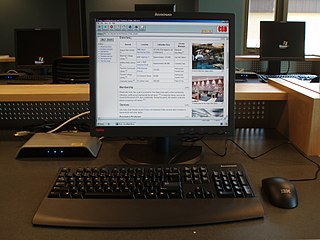
ThinkVision displays are high-end computer monitors manufactured, designed and developed by IBM and Lenovo.

In computing, multi-touch is technology that enables a surface to recognize the presence of more than one point of contact with the surface at the same time. The origins of multitouch began at CERN, MIT, University of Toronto, Carnegie Mellon University and Bell Labs in the 1970s. CERN started using multi-touch screens as early as 1976 for the controls of the Super Proton Synchrotron. Capacitive multi-touch displays were popularized by Apple's iPhone in 2007. Multi-touch may be used to implement additional functionality, such as pinch to zoom or to activate certain subroutines attached to predefined gestures using gesture recognition.
The Modbook is a brand of a pen-enabled Mac tablet computers first manufactured by Axiotron, Inc. from 2008 to 2010, and then by Modbook Inc. from 2012 to present. It is an aftermarket Mac conversion based on certain models of the MacBook and MacBook Pro product lines manufactured by Apple.

The HTC Touch HD, also known as the HTC T828X or its codename the HTC Blackstone, is a Windows Mobile 6.1 Pocket PC designed and manufactured by HTC launched in 2008.

HP TouchSmart is a series of tablet PC laptops and touchscreen all-in-one desktop computers designed by HP. It features various Intel or AMD processors and runs Windows Vista or Windows 7 as standard.

The HTC Touch Pro2 is a slate smartphone, part of the Touch series of Internet-enabled, Windows Mobile, Pocket PC smartphones designed and marketed by HTC Corporation of Taiwan. It is an enhanced version of the HTC Touch Pro with a left-side slide-out QWERTY keyboard, with tilting screen. The Touch Pro2 smartphone's functions include those of a camera phone and a portable media player in addition to text messaging and multimedia messaging. It also offers Internet services including e-mail, instant messaging, web browsing, and local Wi-Fi connectivity. Visual voicemail is not a standard feature for the Touch Pro2, unlike its predecessor the Touch Pro. The Verizon Wireless version does include a visual voicemail application, however. All versions feature TouchFLO 3D — a new enhanced version of the TouchFLO interface, unique only to the latest Touch series. The latest update renamed TouchFLO 3D to SenseUI, to match HTC's Android offering. The Touch Pro2 — along with its sister model, the Touch Diamond2 — were unveiled on February 16, 2009 in Barcelona, Spain at the Mobile World Congress 2009. Specific enhancements over the original Touch Pro include:
The form factor of a mobile phone is its size, shape, and style, as well as the layout and position of its major components.
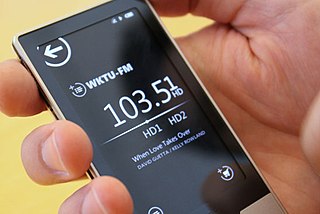
The Zune HD is a portable media player in the Zune product family released on September 15, 2009, by Microsoft. It was a direct competitor with Apple's iPod Touch series of mobile devices. It was initially released in 16 and 32 GB capacities. A 64 GB version was released on April 9, 2010. It has a touchscreen interface for navigation and included Wi-Fi for synchronization, access to the Zune Marketplace and Web browsing.

Sony Ericsson Aino is a touch screen based slider mobile phone. It has a multimedia PlayStation 3-inspired touch menu, a large 3-inch (76 mm) touchscreen, VGA@30 FPS video recording. The 3-inch (76 mm) screen is touch-enabled but only in the multimedia part of the menu and the camera interface. Some third party applications like Opera-Mini also support the touch screen interface. It also has an 8.1-megapixel camera. The Aino uses NetFront 3.5 web browser for internet connectivity.

The Sony Ericsson Vivaz (U5i) is a smartphone, announced by Sony Ericsson on 21 January 2010. It was released on 5 March 2010 in the color schemes Moon Silver, Cosmic Black, Galaxy Blue and Venus Ruby.

BlackBerry Torch is a series of smartphones manufactured by BlackBerry Ltd. The lineup consists of the following:
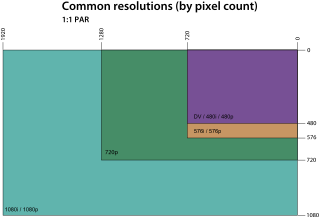
A display resolution standard is a commonly used width and height dimension of an electronic visual display device, measured in pixels. This information is used for electronic devices such as a computer monitor. Certain combinations of width and height are standardized and typically given a name and an initialism which is descriptive of its dimensions.
The Nokia C6-01 is a Symbian^3 smartphone from the Nokia Cseries. The C6-01 display features comes with a 3.2in AMOLED display with capacitive touchscreen capabilities and Nokia's ClearBlack technology for improved outdoor visibility. The smartphone was released on November 4, 2010 for €260, excluding taxes and subsidies.

The HP Pre 3, styled as Pre3, is a touchscreen slider smartphone manufactured by Hewlett-Packard. The device uses webOS, is powered by a Qualcomm Snapdragon processor, and has a 3.6-inch screen. It is conceptually the successor to the Palm Pre 2 and earlier Pre and Pre Plus models.
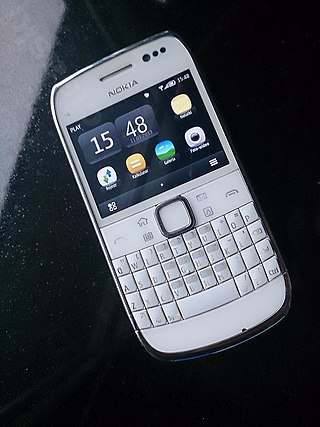
The Nokia E6-00 is a mobile phone running the Symbian^3 operating system. It supersedes the Nokia E72 as the new Symbian business mobility solution from Nokia following its announcement on 12 April 2011. It shipped with the new "Symbian Anna" version of Symbian^3, and originally retailed for 340 euros before taxes.
















